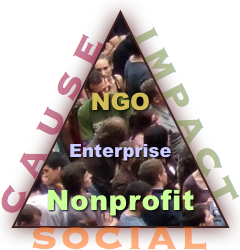By Christopher Rollyson  Nonprofits and experiential social media shares how nonprofits can improve their social media results and why I think experiential social media has an affinity for cause-focused organizations. This post was triggered by my insights from my recent research on nonprofits and cause-focused organizations. Although I’d served nonprofits throughout my consulting career, my focus was on commercial firms. While organizing Chicago Social Empowerment [Cohort One], I researched many nonprofits to distill the cohort’s categories, so I learned more about nonprofit operations and business models. Nonprofits and experiential social media shares how nonprofits can improve their social media results and why I think experiential social media has an affinity for cause-focused organizations. This post was triggered by my insights from my recent research on nonprofits and cause-focused organizations. Although I’d served nonprofits throughout my consulting career, my focus was on commercial firms. While organizing Chicago Social Empowerment [Cohort One], I researched many nonprofits to distill the cohort’s categories, so I learned more about nonprofit operations and business models.
First, I’ll share some broad insights about nonprofit operations and business models, specifically focusing on their stakeholders, and broad guidance for improving their results with social media. Then I’ll share insights about experiential social media and why I hypothesize that it has a special affinity for nonprofits.
For brevity, I’ll also use “nonprofit” to refer to social enterprises and other cause-focused organizations. Continue reading Nonprofits and Experiential Social Media
By Christopher Rollyson  The Potential of Female Leadership explores what lessons we may learn from bonobos’ matriarchal social structure, so we can build stronger, more collaborative human communities and groups. Bonobo Handshake is an enthralling insightful book, which I review here. A tremendous bonus is its similarities to and significant differences from Chimpanzee Politics (reviewed yesterday). The Potential of Female Leadership explores what lessons we may learn from bonobos’ matriarchal social structure, so we can build stronger, more collaborative human communities and groups. Bonobo Handshake is an enthralling insightful book, which I review here. A tremendous bonus is its similarities to and significant differences from Chimpanzee Politics (reviewed yesterday).
Bonobo Handshake was on the same library shelf as Chimpanzee Politics, but it is a very different book, and in delightful ways. At the same time, it offers intriguing insight into bonobos’ behavior, which differs significantly from chimpanzees’ and holds interesting lessons for human societies and groups. Although Woods is not a primatologist per se, she has conducted extensive research with her husband, who is, so explaining scientific experiments forms a key part of this book.
Bonobo Handshake is rare in a surprising way. Deftly and subtly, it contrasts the joy, harmony and matriarchal structure of the bonobos with chimpanzees’ and humans’ patriarchal societies and violence: the wars in and around the two Congos result in the murder of chimpanzees and bonobos because people hunt them for food, and humans have been murdered and women raped en masse for years now. I felt that Woods did this without judgment, almost like her curiosity and the juxtaposition of events produced the contrast spontaneously. So the book is a story within a story. Continue reading The Potential of Female Leadership
By Christopher Rollyson  Unique, Insightful and Useful Guide to Business and Civil Politics reveals human political strategies through the eyes of a primatologist studying a chimpanzee community. It lays bare most of the behavior people use “to get ahead” in business and politics by explaining the evolutionary underpinnings of these behaviors, so we can appreciate them at a new level. Unique, Insightful and Useful Guide to Business and Civil Politics reveals human political strategies through the eyes of a primatologist studying a chimpanzee community. It lays bare most of the behavior people use “to get ahead” in business and politics by explaining the evolutionary underpinnings of these behaviors, so we can appreciate them at a new level.
Have you ever heard someone say, “I’m not political!”? S/He may mean well, but this book shows that one cannot be human without being “political”; moreover, it explains political behavior in hilarious, poignant ways that help the reader in multiple ways as I detail here. It is immensely entertaining to read while being scientific in its assertions. Continue reading Unique Guide Business Civil Politics
By Christopher Rollyson  True love for customers reveals how nonprofit, commercial and government organizations of all sizes can create much stronger relationships and business by transforming how they relate to customers. True love for customers reveals how nonprofit, commercial and government organizations of all sizes can create much stronger relationships and business by transforming how they relate to customers.
Philosophers, clergy and psychologists have long acknowledged love as the most powerful force between humans. Love connects people like nothing else can, I think because love touches and binds together so many parts of the brain simultaneously: Love stimulates the reptilian brain because it’s related to survival. It is central to the limbic brain, which is grounded in emotion and memory. And love throughly engages the neocortex in art, ideals, and many other forms. Continue reading True Love for Customers
By Christopher Rollyson  Use Scenarios to Network into Jobs and Contracts reveals a new way to break through when you’re looking for new consulting work or employment for yourself, or you’re fundraising for your startup or nonprofit. As these pages detail, I’ve learned that “breaking through the noise” is easy when you play music. You’ll learn how to do it here. Continue reading Use Scenarios to Network into Jobs Use Scenarios to Network into Jobs and Contracts reveals a new way to break through when you’re looking for new consulting work or employment for yourself, or you’re fundraising for your startup or nonprofit. As these pages detail, I’ve learned that “breaking through the noise” is easy when you play music. You’ll learn how to do it here. Continue reading Use Scenarios to Network into Jobs
By Christopher Rollyson  Why T-Mobile Needs a Chief Customer Officer shows how customers’ omni-channel interactions with enterprises demand profound integration of business processes, and how firms’ failure to “go all the way” in breaking down silos ultimately threatens business. Most firms don’t go far enough, including T-Mobile, and their silo-centric efforts fail to get the job done. To illustrate the point, I’ll share how T-Mobile alienates fans like me by not delivering what they promise. Why T-Mobile Needs a Chief Customer Officer shows how customers’ omni-channel interactions with enterprises demand profound integration of business processes, and how firms’ failure to “go all the way” in breaking down silos ultimately threatens business. Most firms don’t go far enough, including T-Mobile, and their silo-centric efforts fail to get the job done. To illustrate the point, I’ll share how T-Mobile alienates fans like me by not delivering what they promise.
This story also shows that the need for a CCO is particularly acute in mature economies like the U.S.A. and Europe because their silos were built decades ago, and their legacy processes often adversely affect customer experience. Continue reading T-Mobile Chief Customer Officer Needed
By Christopher Rollyson  Ethnographic research for cross border business shows how to apply ethnographic research of social media to reducing the risks and costs of doing cross border business and deals. Ethnographic research can transform the value proposition of international business because it’s a very efficient way to conduct due diligence, to study the behavior and motivations of the people that the deal proposes to serve. Unlike traditional research methods, which are relatively slow, costly and qualitative, ethnographic research of social media combines qualitative richness with quantitative analysis. It’s faster and less costly, too. Ethnographic research for cross border business shows how to apply ethnographic research of social media to reducing the risks and costs of doing cross border business and deals. Ethnographic research can transform the value proposition of international business because it’s a very efficient way to conduct due diligence, to study the behavior and motivations of the people that the deal proposes to serve. Unlike traditional research methods, which are relatively slow, costly and qualitative, ethnographic research of social media combines qualitative richness with quantitative analysis. It’s faster and less costly, too.
Ethnographic research for cross border business can dramatically improve the depth and breadth of research for business and corporate strategy, market entry strategy, customer development, human capital strategy, product management, and others since it allows teams to consider more users and to assess their behavior and motivations, which can improve the value of more costly research.
Imagine that you can get deep qualitative and quantitative data on what your proposed clients, customers, employees and partners are discussing among themselves, specifically about the business scenario you propose to address. Ethnographic allows you to validate, with real people, market entry strategy, at a fraction of the cost and time of any other method.
Continue reading Ethnographic Research Cross Border Business
By Christopher Rollyson  Customer experience and experiential social media shows how you can succeed in transforming your customers’ experiences with your firm by adopting a refreshing and effective human approach. Transforming customer experience enables most firms to become more resilient and profitable. Customer experience and experiential social media shows how you can succeed in transforming your customers’ experiences with your firm by adopting a refreshing and effective human approach. Transforming customer experience enables most firms to become more resilient and profitable.
If you’d like to watch this post instead of reading it, click the thumbnail button. Continue reading Customer Experience and Experiential Social Media
By Christopher Rollyson  Customer success and experiential social media identifies three pitfalls that too often prevent customer success initiatives from attaining their potential for improving customer experience. In case you’re not familiar with the customer success movement, I outline its origins and scope, so you can appreciate the pitfalls and avoid them. Customer success and experiential social media identifies three pitfalls that too often prevent customer success initiatives from attaining their potential for improving customer experience. In case you’re not familiar with the customer success movement, I outline its origins and scope, so you can appreciate the pitfalls and avoid them.
If you’d like to watch this post instead of reading it, just click its thumbnail. Continue reading Customer Success and Experiential Social Media
By Christopher Rollyson  Employee engagement and experiential social media shares my insights into one of the biggest challenges faced by business today—the employee engagement crisis, and how firms can change the game. Fewer than a quarter of employees are engaged, a slightly smaller quarter are “actively disengaged,” and the majority is blasé and punches the clock. Employee engagement and experiential social media shares my insights into one of the biggest challenges faced by business today—the employee engagement crisis, and how firms can change the game. Fewer than a quarter of employees are engaged, a slightly smaller quarter are “actively disengaged,” and the majority is blasé and punches the clock.
If you’d like to watch this post instead of reading it, click the thumbnail button. Continue reading Employee Engagement and Experiential Social Media
|
|
 Nonprofits and experiential social media shares how nonprofits can improve their social media results and why I think experiential social media has an affinity for cause-focused organizations. This post was triggered by my insights from my recent research on nonprofits and cause-focused organizations. Although I’d served nonprofits throughout my consulting career, my focus was on commercial firms. While organizing Chicago Social Empowerment [Cohort One], I researched many nonprofits to distill the cohort’s categories, so I learned more about nonprofit operations and business models.
Nonprofits and experiential social media shares how nonprofits can improve their social media results and why I think experiential social media has an affinity for cause-focused organizations. This post was triggered by my insights from my recent research on nonprofits and cause-focused organizations. Although I’d served nonprofits throughout my consulting career, my focus was on commercial firms. While organizing Chicago Social Empowerment [Cohort One], I researched many nonprofits to distill the cohort’s categories, so I learned more about nonprofit operations and business models.








